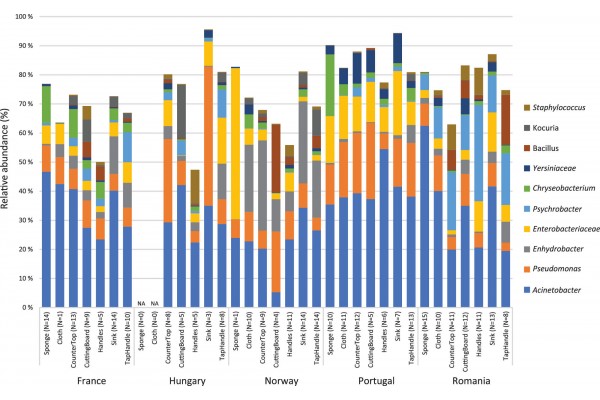Bacteria in Kitchen May Not Be as Harmful as You Think
July 13, 2023
Source: drugdu
 325
325

Relative abundance (%) of the 10 most abundant genera/families in the different sample types and countries. The values are based on the average of similar sample types within each country. The number of samples (N) representing each bar is written in parentheses after the sample type. There were no sponges or cloths from Hungary (marked NA in the figure).
Bacteria found in 74 kitchens spread among five European countries were mostly harmless according to new research published in Applied and Environmental Microbiology.
"We have previously found considerable variations in kitchen standards, food preparation practices, and cleaning regimes between France, Norway, Portugal, Romania and Hungary," said Birgitte Moen, Ph.D., Scientist—Department of Food Safety and Quality, Nofima—Norwegian Institute of Food, Fisheries and Aquaculture Research, Ås, Norway.
In the study, the researchers sampled bacteria populations from sinks, cutting boards, countertops, handles and cleaning utensils—sponges and cloths—used in kitchens.
Despite large numbers of species and considerable differences in bacterial diversity between samples, the researchers identified eight bacterial genera commonly associated with environmental sources in most of the kitchens they sampled, which they characterized as "core microbiota." These included Acinetobacter, Pseudomonas, Enhydrobacter, Enterobacteriaceae, Psychrobacter, Chryseobacterium, Bacillus and Staphylococcus.
In the report, the authors stressed that the core microbiota persisted despite considerable differences between kitchens in the study. Some kitchens lacked running water, some lacked an indoor sink and some lacked dishwashers. They also persisted despite differing food preparation methods, dietary habits and differences in hand and kitchen hygiene, both of which affect the probability of infection.
The study was motivated by the authors' curiosity, said Moen. Bacteria in food, in the gut, in hospitals and in professional food production had been well researched, but little was known about the microbes that inhabit the domestic kitchen. With an already existing collaboration across countries, "we had a unique opportunity to dig into this," Moen added.
The team knew that harmful bacteria enter kitchens via contaminated food, and that the type of these bacteria varied across countries. For example, Salmonella is not a problem in Norway, but it is the most commonly reported cause of foodborne illness in mainland Europe. Knowledge of the bacteria inhabiting the domestic kitchen could be used to help prevent human illness, and perhaps could even lead to more hygienic kitchen designs and better cleaning utensils, said Moen.
Source: Applied and Environmental Microbiology
By editorRead more on
- Phase III Clinical Trial of Recombinant Staphylococcus Aureus Vaccine Progressing Normality January 21, 2026
- Its drug marketing application for injectable iza-bren has been accepted January 21, 2026
- Kain Technology withdrew a drug registration application, resulting in a profit reduction of 111 million yuan in 2025 January 21, 2026
- Received Notice of Approval for Drug Clinical Trial January 21, 2026
- Breaking news! AstraZeneca to be delisted from Nasdaq. January 21, 2026
your submission has already been received.
OK
Subscribe
Please enter a valid Email address!
Submit
The most relevant industry news & insight will be sent to you every two weeks.



